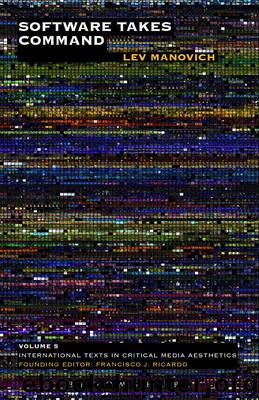Software Takes Command by Manovich Lev;

Author:Manovich, Lev;
Language: eng
Format: epub
Publisher: Bloomsbury Publishing
Published: 2013-03-21T16:00:00+00:00
Hybridity: examples
The examples of media hybrids are all around us: they can be found in user interfaces, web applications, mobile apps, visual design, interactive design, visual effects, locative media, interactive environments, digital art, and other areas of digital culture. Here are a few examples that I have deliberately drawn from different areas. Created in 2004 by Stamen Design (San Francisco), Mappr was one the first popular web mashups.17 It combined a geographic map and photos from Flickr.18 Using information entered by Flickr users, the application guessed geographical locations where photos were taken and displayed them on the map. (Today similar map interfaces to photo collections that use GPS data captured with photos are available for iPhoto, Instagram, and other photo services and apps.) Since May 2007, Google Maps has offered Street Views that add panoramic photo-based views of city streets to other media types already used in Google Maps.19 A hybrid between photography and interfaces for space navigation, Street Views allows users to navigate through a space on a street level by clicking on the arrows superimposed on the panoramic photographs.20
Starting in 1991, Japanese media artist Masaki Fujihata created a series of projects called Field Studies.21 These projects place video recordings made in particular places within highly abstracted 3D virtual spaces representing these places. Fujihata started to work on Field Studies a decade before the term “locative media” made its appearance. As cameras with built-in GPS did not yet commercially exist at that time, the artist created a special video camera which captured geographical coordinates of each interview location—along with the camera’s direction and angle while he was video-taping the interview, as well as his movement though space. The artist used this captured information to create a media interface which combined 3D navigable space and video in a unique way.
For instance, to create the interactive installation Field-Work@Alsace (2002),22 Fujihata recorded a number of video interviews with the people living in and passing through the area around the border between France and Germany. The project confronts us with a black screen, with a number of three-dimensional white lines showing the artist’s movement through the area as he was capturing the interviews. As we navigate around the space, the changing perspective views of these lines suggest the shapes of the Alsace terrain. We also see a number of flat rectangles that are positioned at points where each interview was recorded. Each rectangle is situated at a unique angle that corresponded to the angle of the hand-held video camera during the interview. When you click on a rectangle, the corresponding video plays inside.
In my view, Alsace represents a particularly interesting media hybrid. It fuses photography (still images which appear inside rectangles), video documentary (video playing once a user clicks inside a rectangle), the locative media (the movement trajectories recorded by GPS) and 3D virtual space. In addition, Alsace uses a new media technique developed by Fujihata: the recording not just of the 2D location but also of the 3D orientation of the camera.
Download
This site does not store any files on its server. We only index and link to content provided by other sites. Please contact the content providers to delete copyright contents if any and email us, we'll remove relevant links or contents immediately.
| Content Management | Programming |
| User Experience & Usability | User Generated Content |
| Web Design | Web Marketing |
| Web Services | Website Analytics |
Hello! Python by Anthony Briggs(9938)
The Mikado Method by Ola Ellnestam Daniel Brolund(9805)
Dependency Injection in .NET by Mark Seemann(9364)
Sass and Compass in Action by Wynn Netherland Nathan Weizenbaum Chris Eppstein Brandon Mathis(7803)
The Well-Grounded Java Developer by Benjamin J. Evans Martijn Verburg(7582)
Svelte with Test-Driven Development by Daniel Irvine(7368)
Test-Driven Development with PHP 8 by Rainier Sarabia(7111)
Layered Design for Ruby on Rails Applications by Dementyev Vladimir;(6966)
Secrets of the JavaScript Ninja by John Resig & Bear Bibeault(6550)
Secrets of the JavaScript Ninja by John Resig Bear Bibeault(6440)
Web Development with Django by Ben Shaw Saurabh Badhwar(6431)
React Application Architecture for Production by Alan Alickovic(6154)
Jquery UI in Action : Master the concepts Of Jquery UI: A Step By Step Approach by ANMOL GOYAL(5827)
Kotlin in Action by Dmitry Jemerov(5087)
Audition by Ryu Murakami(4604)
Software Architecture for Web Developers by Mihaela Roxana Ghidersa(4560)
Accelerating Server-Side Development with Fastify by Manuel Spigolon Maksim Sinik & Matteo Collina(4414)
Hands-On Full-Stack Web Development with GraphQL and React by Sebastian Grebe(4332)
Solidity Programming Essentials by Ritesh Modi(4117)
